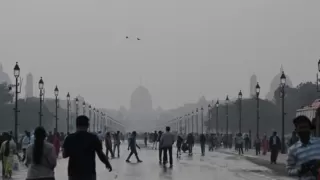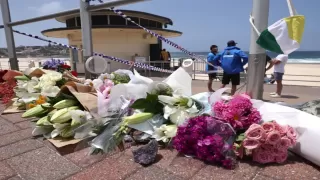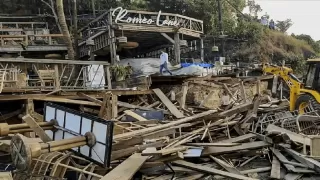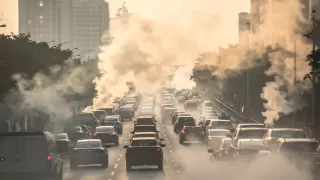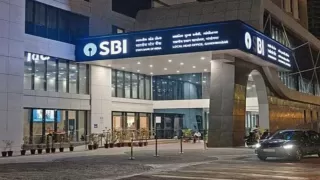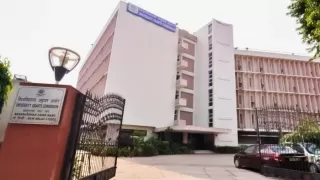The emergence of a 45-second CCTV video capturing the exact moment of a powerful explosion outside a paramilitary headquarters in Peshawar has brought renewed focus to the intensity of the blast and its devastating impact. In the footage, an injured person is seen attempting to walk past the gate moments after the explosion, highlighting the sheer force of the detonation. The sound of the blast is audible from a significant distance, further amplifying the fear and chaos that unfolded during the attack.
The incident, which claimed the lives of at least three security personnel, unfolded during a busy morning rush around 8 a.m. The attack targeted the Federal Constabulary (FC) headquarters, a major paramilitary installation in Peshawar, and involved multiple suicide bombers. The visuals from the leaked video continue to circulate widely, giving viewers a chilling glimpse into one of the most serious security breaches reported in recent times.
Security personnel and emergency responders swiftly reached the site, where rescue efforts and countermeasures were launched immediately. The attacker's approach, the sudden eruption of the explosion near the main entrance, and the ensuing commotion all contribute to a narrative of a meticulously planned strike. The video has deepened concerns about security vulnerabilities surrounding Pakistan’s sensitive installations and the rising frequency of targeted strikes.
Attack Sequence Captured in CCTV Footage
The CCTV footage opens with a guard seated near the gate of the paramilitary compound. Moments later, a sudden flash and a massive blast engulf the area, momentarily obscuring the surroundings. The 45-second clip provides a stark visual of how unexpectedly the explosion occurred, catching those present off guard. The injured individual seen staggering inside the gate reveals the immediate human toll of the assault.
Emergency vehicles, startled civilians, and personnel can be seen reacting in the aftermath, rushing to escape or assess damage. The footage underscores how the attack disrupted the otherwise routine morning and reinforced the dangers posed by coordinated suicide missions in densely populated urban regions.
Officials have stated that while the authenticity of the video is still being examined, the visuals align with the sequence of events described by witnesses and authorities at the scene. The presence of smoke, scattered debris, and panicked movements strengthens the claim that the footage was captured at the precise time of the explosion.
Details of the Suicide Bombing Attempt
According to officials, three suicide bombers attempted to storm the headquarters. One attacker detonated himself at the main gate, triggering the explosion seen in the CCTV clip. The two other militants reportedly entered the premises but were neutralized in counterfire before they could inflict further damage.
The attack occurred on a busy road adjacent to the Federal Constabulary compound, intensifying the danger for nearby residents and commuters. Eyewitnesses reported hearing a thunderous explosion that shook the area, prompting widespread panic and instantaneous evacuation by those present.
Security personnel at the gate acted swiftly, engaging the militants who breached the perimeter. Their quick response helped limit the scale of destruction, preventing the attackers from reaching critical areas inside the headquarters. The presence of multiple suicide bombers, however, has led to increased scrutiny of how they managed to approach the facility without early detection.
Reactions from Security and Emergency Authorities
Authorities described the attack as an aggressive and deliberate attempt to cause mass casualties within a high-security zone. Statements from law enforcement confirmed that two separate explosions were heard—one at the main gate and another near a motorcycle stand located inside the premises.
Rescue teams transported the injured to nearby hospitals, where at least five individuals, including three civilians, were treated for blast-related injuries. The loudness of the explosion caused alarm across surrounding neighborhoods, with several residents reporting the sound from a considerable distance.
The Inspector General of Police confirmed that the attack coincided with an assembly of personnel taking place in the compound at the start of the workweek. This timing has raised concerns about whether the attackers intended to inflict maximum casualties by targeting a routine gathering.
Impact on Surrounding Areas and Public Response
The magnitude of the explosion caused windows to rattle and sparked confusion across adjoining markets, residential buildings, and public spaces. Many residents took to social platforms to express fear and recount how they felt the shockwave moments after the blast.
The sudden eruption of the explosion prompted vehicles near the entrance to speed away from the site. People inside the compound scrambled to find cover as clouds of dust and smoke filled the air. The shockwaves disrupted not only the premises but also surrounding shops and establishments, where owners rushed to assess damage.
The attack has once again ignited discussions about the growing security challenges in regions bordering sensitive zones. Public sentiment reflects both anger and anxiety, with citizens demanding stronger intelligence-based operations to prevent similar attacks.
Security Gaps and Concerns Raised After the Attack
The attack has brought renewed attention to security lapses and the vulnerabilities within institutional setups. Experts note that the use of multiple suicide attackers suggests coordinated planning and knowledge of the compound’s layout.
The challenge of preventing such attacks lies in the unpredictability and mobility of suicide bombers. Their ability to blend into crowds or approach sensitive areas during peak hours continues to be a major hurdle for security forces.
In light of the incident, calls for enhanced surveillance, increased patrolling, and improved screening infrastructure have surfaced. The event has also fueled discussion about integrating advanced technologies, such as AI-based monitoring systems, to detect suspicious movement before an attack unfolds.
Eyewitness Accounts and Local Responses
Several eyewitnesses described the blast as deafening, with many initially mistaking it for an earthquake or a collapsing structure. Residents near the site recounted how the ground trembled and thick plumes of smoke engulfed the area shortly after the explosion.
Shopkeepers in the vicinity said they saw injured individuals being carried away and vehicles driving erratically in a panicked attempt to flee the scene. The rapid arrival of security forces and medical teams helped stabilize the situation, but fear lingered long after the attack.
People living and working around the area continue to express concern about their safety, urging authorities to establish more stringent protection measures for high-risk zones. The presence of multiple attackers has particularly heightened anxiety among those who regularly pass through or work near the compound.
Ongoing Investigation and Security Review
Authorities have launched a detailed investigation to uncover the identities and affiliations of the attackers. Early reports suggest that intelligence agencies are working to trace the network behind the coordinated strike. Forensic teams have collected evidence from the blast site, including explosive residues and weapon fragments.
Investigators are also examining how the attackers managed to reach the main gate without arousing suspicion, despite existing security protocols. CCTV recordings from various angles are being reviewed to piece together the attackers’ movements before the explosion.
Security analysts believe the motive behind the attack may extend beyond targeting the paramilitary headquarters and could be part of a broader attempt to create instability. The findings of the investigation are expected to influence future counterterrorism strategies and reinforce security measures across sensitive installations.
Aftermath and Security Strengthening Measures
In the hours following the explosion, security across Peshawar and adjoining districts was heightened. Additional checkpoints were established, and security forces conducted search operations in the surrounding areas to ensure no further threats persisted.
The attack has prompted renewed directives to reassess and fortify the perimeter security of major installations. Training programs for guards and rapid-response personnel are expected to be reinforced, with emphasis on identifying suspicious behavior and managing multi-attacker scenarios.
While the investigation continues, the incident serves as a stark reminder of the evolving nature of security challenges in the region. The visuals from the CCTV footage, combined with firsthand accounts, leave a lasting impression of the magnitude and severity of the attack, prompting urgent calls for comprehensive safety reforms.
Also Read: Nifty Hits 25,100; Sensex Opens Strong as IT Stocks Surge





